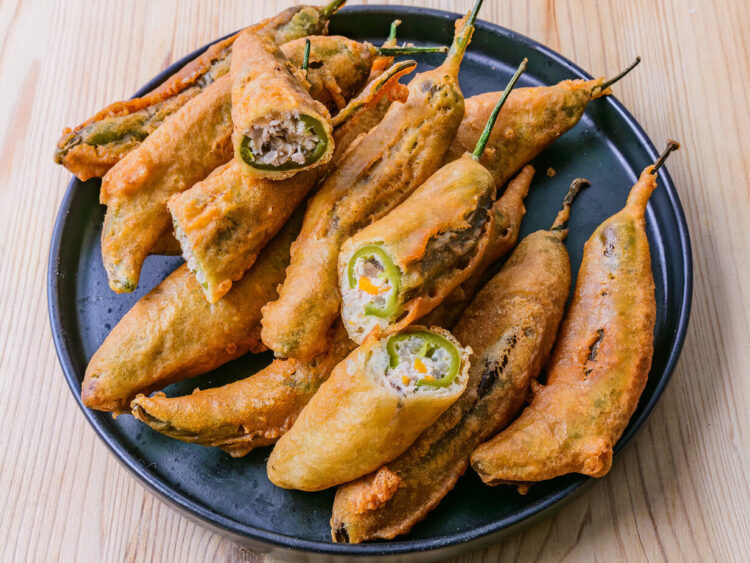A traditional recipe for Korean stuffed chili fritters—a simple and delicious treat!
A wisp of steam rises from a freshly fried chili, held by its stem. With the first bite, the batter shatters, releasing garlicky pork juices, while the chili delivers a gentle but lingering heat.
Think of it as the Korean answer to the jalapeño popper, the North American stuffed chili fritter, but without the fiery burn or thick breading. What makes gochu twigim unforgettable is a perfect trio: the subtle kick of a fresh green chili, a juicy, flavorful filling, and a batter so thin it crackles rather than crunches.
Miss any one of these elements and the magic is lost. Bring them together and you’ll understand why everyone, from busy office workers to late-night students, can’t get enough of them.

The Origins of Gochu Twigim
Chilies found their way into Korean kitchens around 1600, carried by the same global currents that brought them to China and Japan. Early cooks chopped them for kimchi or stuffed them for jeon, pan-fried instead of deep-fried. The modern era of twigim began in the mid-20th century.
Japanese tempura techniques merged with the emerging bunsik snack culture. Street vendors discovered that an ice-cold, airy batter let plump chilies puff up without soaking up oil. By the 1980s, markets from Gwangjang in Seoul to the stalls of Busan were already perfuming alleyways with that unmistakable aroma of fried chili, a sharp contrast to milder dishes like bindaetteok.
Regional twists soon followed. In Chungcheong, fry masters turned up the heat by stuffing local Cheongyang chilies or adding mozzarella for a gooey center. In Gwangju, the opposite: various twigim (including pieces of gochu twigim) are wrapped in lettuce leaves (sangchu twigim) for a fresh crunch to balance the richness. Whether it’s a party challenge (“chili roulette” with one extra-hot pepper hidden in the batch) or a classic beer snack, gochu twigim is all about sharing: quick, affordable, a little daring, and impossible to stop at just one.
Inside the Chili: Authentic Ingredients and Preparation

The chili comes first. Vendors favor mild Korean green chilies, medium in length (about 8–12 cm): big enough to stuff, thin enough to blister.
A simple slit turns each chili into a natural piping bag, ready for the sok: a filling of ground pork, pressed tofu, and finely chopped glass noodles, with the pork (ideally 30% fat) usually making up the bulk. Garlic, soy sauce, chopped carrot, onion, and scallions add flavor, finished with a splash of sesame oil. Dusting the inside of the chili with flour before filling helps keep the promise Koreans love to see: 속이 꽉 찬, “generously stuffed.”
The batter is where many imitators stumble. True artisans whisk equal parts flour and potato starch with ice-cold water—or very cold sparkling water for extra lightness—until it’s nearly translucent. No breadcrumbs, no panko; egg is usually left out, or added in small amounts for color.
At 170–180°C, the chilies float and sizzle for about five minutes, their skins bubbling under a nearly transparent shell. Some stalls give them a quick second fry just before serving; the result stays crisp even after a dunk in tteokbokki sauce.
Variations and Pitfalls: Authentic Twists vs. Imitations
Many variations remain true to Korea: swapping in Cheongyang chilies for a fiery kick; adding mozzarella alongside the meat for a melty center; or mixing chopped shrimp into the filling for a coastal touch.
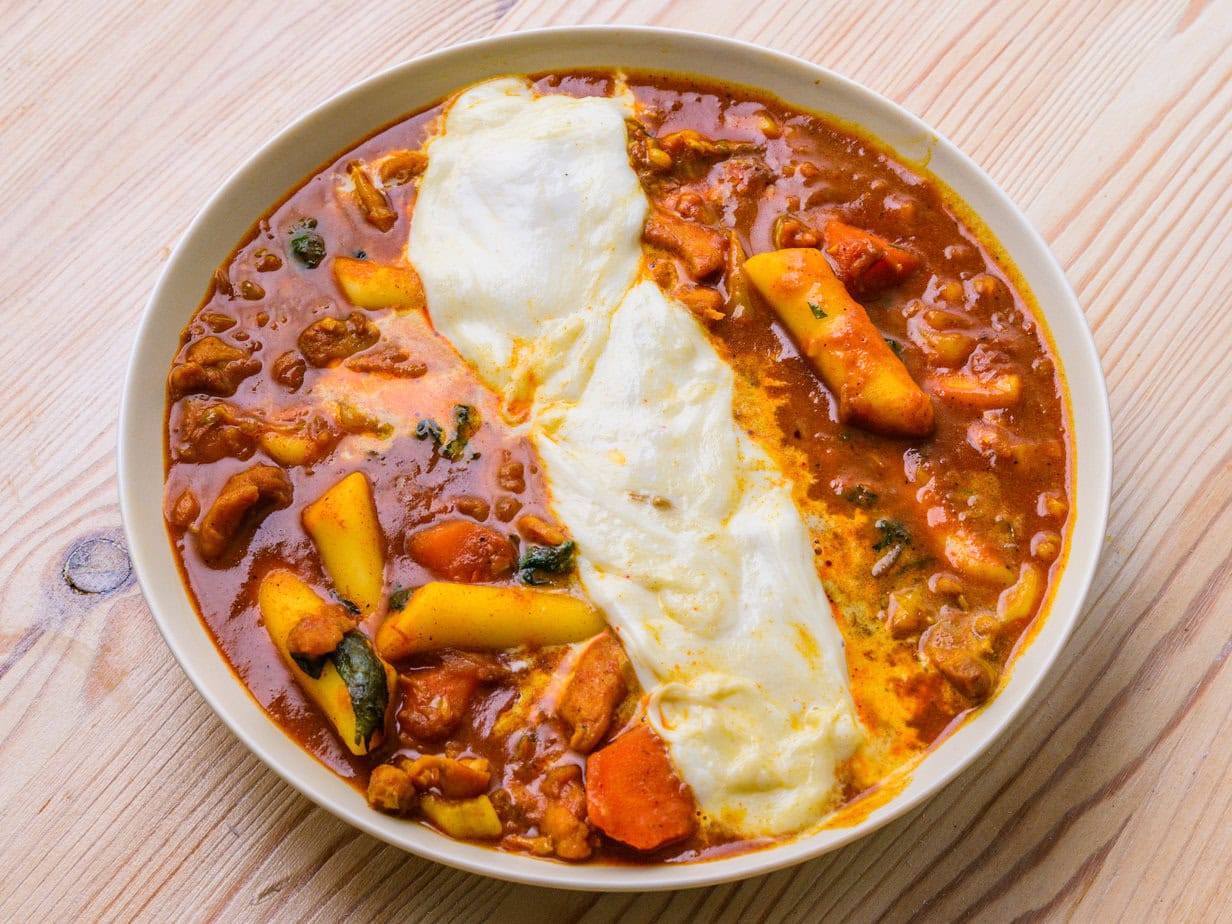
Beyond that, beware. If the coating reminds you of a chicken nugget, it’s not twigim. Ranch or ketchup on the side? That’s a bar parody. Chilies stuffed only with cheese and bacon bits are pure jalapeño popper, not Korean market fare. Here’s your cheat sheet: visible protein in the filling, batter as fluid as syrup, and a soy-vinegar dip. Miss any of these and you’re in fusion territory.
How Should You Eat It?
As soon as a chili comes out of the fryer, it should be in your hand—scorching hot, dripping into its cardboard tray. Most locals dip it in cho-ganjang, an equal mix of soy sauce and rice vinegar, or plunge it straight into a bubbling sea of tteokbokki sauce.
Classic sides include a mixed plate of twigim (sweet potato, seaweed rolls, squid) and a cold glass of lager; cubes of pickled radish reset your palate for the next round.
If someone slips a single Cheongyang chili among the mild ones, bite bravely. The crackle, the chili heat, the sesame-scented filling, the fizz of beer against the fried batter: gochu twigim delivers exactly what it was made for.
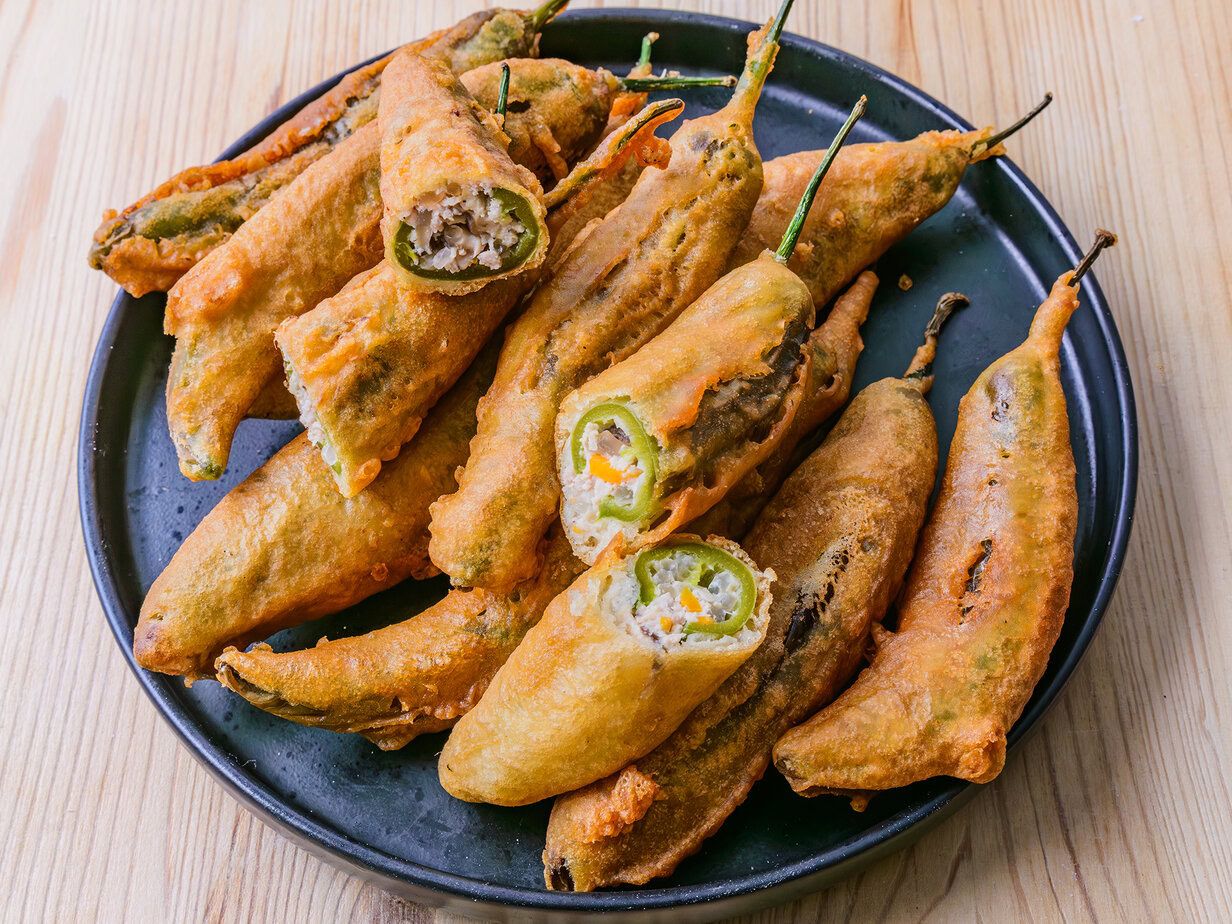
Equipment
Ingredients
- 5 green chili peppers long and meaty
- 100 g firm tofu well-drained
- 200 g ground pork
- 4 fresh shiitake mushrooms
- 0.5 onion
- 20 g carrot
- 15 g sweet potato vermicelli dry weight
Seasonings
- 0.5 teaspoon salt
- 1 pinch black pepper
- 1 clove garlic minced
- 1 tablespoon Shaoxing wine
- 1 egg
Batter
- 150 ml ice-cold water
- 1 egg beaten
- 90 g flour
- 3 tablespoons cornstarch
- 2 teaspoons baking powder
- 0.25 teaspoon salt
- 0.25 teaspoon garlic powder
- 1 pinch white pepper
Instructions
Preparation
- Soak the sweet potato vermicelli in hot (not boiling) water for 25 minutes.15 g sweet potato vermicelli

- Wash the green chili peppers thoroughly, slit each on one side, and remove the seeds.5 green chili peppers

- Microwave the firm tofu for 2 to 3 minutes to draw out excess moisture.100 g firm tofu
- Finely chop the shiitake mushrooms, onion, and carrot; finely cut the drained sweet potato vermicelli; combine with the ground pork.200 g ground pork, 4 fresh shiitake mushrooms, 0.5 onion, 20 g carrot

- In a large bowl, combine the pressed tofu, salt, black pepper, minced garlic, Shaoxing wine, and the egg, then knead by hand until a smooth, cohesive filling forms.0.5 teaspoon salt, 1 pinch black pepper, 1 clove garlic, 1 tablespoon Shaoxing wine, 1 egg
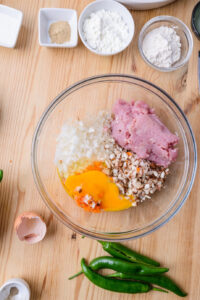
- Lightly flour the inside of each slit pepper to help the filling adhere.90 g flour

- Generously stuff the peppers with the filling.
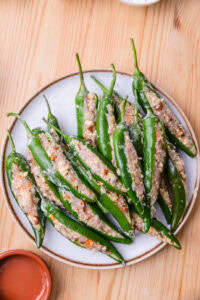
- Coat the stuffed peppers completely with flour.

- For the batter, whisk all the ingredients together in a bowl.150 ml ice-cold water, 1 egg, 3 tablespoons cornstarch, 2 teaspoons baking powder, 0.25 teaspoon salt, 0.25 teaspoon garlic powder, 1 pinch white pepper

- Dip the floured peppers in the batter.
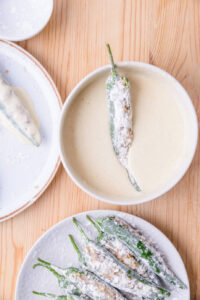
- Fry in hot oil at 160°C until golden.
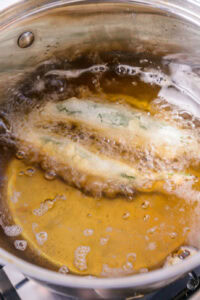
- Let the fritters cool slightly.
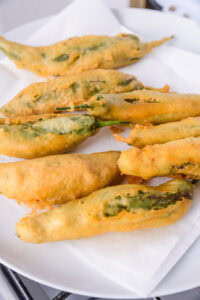
- Fry the fritters a second time at 170°C for an even crispier crust.
Notes
- Keep the batter slightly thick so it clings and doesn’t drip during frying.
- Fry at a moderate 160°C so the pork filling cooks through.
- Serve with a soy-vinegar dipping sauce.
Culinary Sources
- Korean Stuffed Peppers: a step-by-step reference recipe for understanding how to make gochu twigim.
- Famous Korean Street Foods: general cultural context on the role of fried snacks, including gochu twigim, in street food.
- Crispy-Tender Gochu Twigim: a popular variation detailing a typical crispy batter.
- Twigim — Korean Fried Snacks: technical explanations and an overview of different types of twigim.
- History of Gochu Twigim: a historical source tracing the origin and evolution of the dish.
- Regional Diversity of Korean Fried Foods: an overview of fried specialties by region in Korea.
- Sangchu Twigim: Gwangju Specialty: an example of a “cousin” dish to gochu twigim for comparing styles and fillings.
- Video: Gochu Twigim Step-by-Step: a visual demonstration of the techniques.
- Lotteria Chili Croquette (New Product): an example of the dish’s industrial and commercial adaptation.
- Street Fried Squid (Ojingeo Twigim): a comparison of batters and frying times with another twigim specialty.
- Origins of Tempura: a broader historical perspective on frying in Asia to place gochu twigim in context.
- Cheese Gochu Twigim: inspiration for a modern, indulgent filling.
- Quick Gochu Twigim: a simplified method for fast or student cooking.
